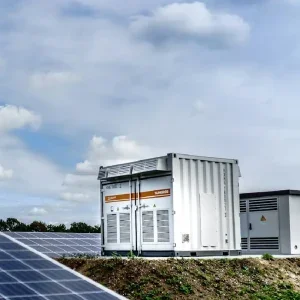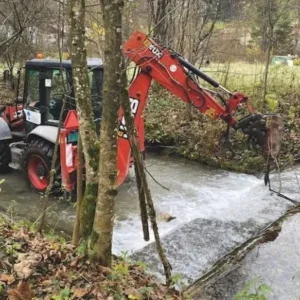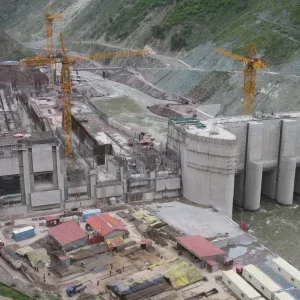
As International Hydropower Association (IHA) reports in its 2023 World Hydropower Outlook, countries in the South American region are making considerable advances in implementing policies and setting targets to increase renewable energy production. In 2022 over 1.5GW of hydropower capacity was installed.
In the Andean region, according to the IHA, Colombia has great hydro potential with capacities exceeding 50GW, supported by its abundant water resources and conducive geographical features. The country was listed as the top eighth country in the world according to added hydropower capacity, with 618MW last year.
Empresas Publicas de Medellin (EPM) launched commercial operation of the first two turbine-generator units of its 2.4 GW Ituango hydropower plant in Colombia. The plant is delivering continuous electricity supply from 600MW of capacity to the national grid and once completed in 2024 will provide 17 per cent of Colombia’s electricity demand from its eight units. Five other hydropower projects also came online in 2022, cumulatively adding a total generation capacity of over 600MW.
In June 2023, South America`s largest floating solar project was also launched at the Urrá Dam in Colombia, aiming to showcase the potential of pairing floating solar with hydroelectric operations to enhance energy reliability and production. Developed by Noria Energy, it comprised a 1.5MW solar power system floating on the reservoir and was a pilot project for independent power producer URRÁ.
The Aquasol pilot installation is situated at the 340MW Urrá hydropower plant in the Sinú River basin in Córdoba. Comprising over 2800 solar modules, it is anticipated to generate nearly 2400MWh of power in its first year, equivalent to the energy required to operate the dam. Additionally, Aquasol is expected to reduce carbon dioxide emissions by over 1540 tons annually and generate over US$1.2 million in additional electric power revenue over a span of 20 years.
“URRÁ seeks to incorporate innovation and sustainable development in all its operations. We are very proud that Aquasol is the largest floating photovoltaic plant built at a reservoir of a hydroelectric power plant in South America to date,” says Rafael Amaya del Vecchio, president of URRÁ.
Noria Energy plans to leverage the data collected from the Aquasol pilot project to compare its production and efficiency against a ground-mounted solar system installed on the shore. Furthermore, the insights gained will assist in designing and modelling larger-scale floating solar and hydroelectric systems to maximise their generation potential, both in Colombia and globally.
Above average
According to the IHA, higher than average rainfall levels in Chile and Colombia during 2022 boosted hydropower output compared to previous years. In Chile specifically, the year-on-year increase for August 2022 was 87 per cent. The country is reported to be ramping up investment in renewable technologies which was reflected in it its rank as the tenth highest country in 2022 for adding 477MW of hydropower capacity, mainly due to the commissioning of the Las Lajas and the Alfalfal II power plants, both part of the same developer, Alto Maipo. While the Ocean Renewable Power Company is also installing the country’s first commercial river hydrokinetic system in the municipality of Chile Chico. The electricity delivered from this will displace diesel fuel in the market.
More favourable rainfall also meant that in 2002 water was spilled from five dams on the Rio Grande River basin in Brazil, which had not happened since March 2011. In December 2022, the level of water in the reservoirs of the country’s southeast/centre-west hydroelectric system was at about 50 per cent of capacity, double what it was a year ago. In 2021 Brazil faced its worst drought in 91 years.
Uruguay is currently in the grips of its worst drought for more than 70 years. On 20 June 2023, it was reported that President Luis Lacalle Pou had declared a state of emergency in the capital Montevideo due to water shortages as the Canelon Grande reservoir was experiencing historically low levels. Then on 15 July more than half of the capital’s three and a half million people were reported to be without water fit for drinking due to the shortages. Critics argue that they had warned about such a dire situation years ago due to a lack of investment in reservoirs and the fact that only one facility supplies the area surrounding the capital city.
In July, the Inter-American Development Bank (IDB) announced it had approved a credit of up to US$800 million to help modernise the 1890MW Salto Grande Binational Hydroelectric Complex in Argentina and Uruguay. The financing will play a vital role in ensuring the reliability and availability of the scheme, as well as extending its operational lifespan while enhancing environmental and social sustainability. Expected to benefit over 17 million users of the interconnected electricity systems in Argentina and Uruguay, Salto Grande was the first binational project in the region and has been a catalyst for electrical system integration in the Southern Cone and has paved the way for future collaborations between Argentina and Uruguay.
Earlier in the year AFRY, in consortium with Latinoconsult, announced it had won the contract to plan and supervise the rehabilitation and modernisation of the 200MW Acaray hydropower plant in Paraguay which was commissioned in 1969.
The first phase of the project will last approximately 20 months, during which AFRY will review previous studies and design technical solutions that will be tendered and ultimately implemented during the second phase of the contract, which will take place over the following 40 months. During the execution of the rehabilitation work, AFRY will supervise the contractors on site and verify the technical and social-environmental compliance of the project.
As hydropower is the main source of clean energy in Paraguay, the 200MW Acaray–Yguazú complex is one of the most important power plants to meet the country’s growing energy demand and to accelerate the sustainability transition. Therefore, it is essential to modernise and further improve the power generation infrastructure with state-of-the-art technology, security systems, monitoring instrumentation and emergency action plans, in order to guarantee the safety of neighbouring population centres and improve the sustainability of the electricity service by ensuring continuity and an increase in renewable energy.
Just recently, Bitfarms Ltd, a global vertically integrated Bitcoin mining company, acquired two Power Purchase Agreements (PPAs) in Paraguay for up to 150MW of eco-friendly hydropower: up to 50MW in Villarrica, in close proximity to the Company’s existing operations in Paraguay, and up to 100MW in Yguazu, a new location close to the Itaipu dam.
“As we approach the next Bitcoin halving, we are seeking to drive growth by leveraging our farm design expertise and drawing upon our operational experience to broaden our geographical presence and optimise global, underutilised power resources,” said Geoff Morphy, CEO of Bitfarms. “Paraguay has access to an abundance of surplus renewable power, and these acquisitions secure valuable, yet limited, sustainable energy contracts while broadening our foothold in a resource-rich country.”
At Villarrica, construction is scheduled to commence in Q3 2023 beginning with a sub-station followed by building out a second mining facility. At Yguazu, Bitfarms has the opportunity to develop a new farm with up to 100MW of mining capacity, the timeline for which is being determined. Hydropower at both locations will be provided at a contracted cost of approximately 3.9 cents per kWh, before VAT, and is not subject to annual inflationary adjustments.
Founded in 2017, Bitfarms is a global, publicly traded Bitcoin mining company. Bitfarms develops, owns, and operates vertically integrated mining farms with in-house management and company-owned electrical engineering, installation service, and multiple onsite technical repair centres.
Bitfarms currently has 11 farms, which are located in four countries: Canada, the United States, Paraguay, and Argentina. Powered predominantly by hydroelectricity and long-term power contracts, Bitfarms said it is committed to using sustainable, locally based, and often underutilized energy infrastructure.
Hydropower is also being used for the production of hydrogen in the country. Earlier this year NeoGreen Hydrogen Corp., a global integrated Green Hydrogen developer, inked a long-term 75MW baseload Power Purchase Agreement (PPA) with ANDE, Paraguay`s national electricity company.
The ambitious project is set to be established in Tres Fronteras, an area where Brazil, Paraguay, and Argentina meet, situated near the Iguazu and Parana rivers. NeoGreen`s venture will primarily focus on producing green fertiliser to serve both the domestic market and regional customers through river exports.
What makes this PPA noteworthy is that it has been agreed upon at the lowest commercial rate, allowing for the production of affordable green ammonia. This will be achieved by utilising electricity generated from Itaipú Dam. Initial estimates suggest that the project will yield approximately 10,000 MT per year of green hydrogen, which will be converted into ammonium nitrate for use in NPK fertilizer blends.
The strategic decision to cater to the domestic market is aimed at providing price stability and reducing the need for import dependency in Paraguay`s substantial agricultural sector. Additionally, the NeoGreen project is expected to inject an estimated US$400 million of inward investment into the region, generating local employment opportunities during the construction and operational phases.
The Final Investment Decision (FID) for the Tres Fronteras Project is anticipated to be made by Q4 2023, with green hydrogen and ammonia production targeted to commence in mid-2026.
Since joining forces with ANDE under the Cooperation Agreement in November 2021, NeoGreen has diligently collaborated with consortium partners and Mott MacDonald to finalize essential studies. The company is now preparing to move the Tres Fronteras project to the Front End Engineering and Design (FEED) stages.
A strategic partnership with Atria Logistica, the largest river and port logistics company in the Paraguay-Paraná waterway, will facilitate the construction of NeoGreen`s industrial plant in close proximity to Atria’s Tres Fronteras port. This location will ideally serve Paraguay`s primary soya-producing areas. Additionally, the project`s proximity to the newly constructed bridge to Brazil will enhance access to significant Brazilian markets, thereby opening up various regional export opportunities for NeoGreen. The port is also the intended location for a new fertilizer mixing plant.
The utilization of green ammonia, derived from green hydrogen through the Haber-Bosch process, is set to play a pivotal role in reducing carbon emissions across multiple heavy industries, including agriculture. The global ammonia market is currently valued at over $66 billion and is projected to surpass $82 billion by 2026. Transitioning all ammonia production to green ammonia by 2050 is vital to achieving global climate targets.
Miles Lewis, President of NeoGreen Paraguay, expressed gratitude to the ANDE team for their support during the project`s initial planning phase. He conveyed confidence in the partnership`s ability to understand and address the challenges and opportunities presented by Paraguay`s climate goals. The signing of the PPA now allows them to accelerate development and aims to begin production by early 2026. The group is also actively exploring the possibility of increasing capacity as per the initial Cooperation Agreement.
Santiago Bautista Herman, Business Development Manager for South Latam at Siemens Energy, emphasized the importance of collaborative alliances in successfully navigating the energy transition towards a low-carbon energy ecosystem.
Ing. Felix Sosa, President of ANDE, hailed the agreement as a crucial milestone in Paraguay`s green hydrogen roadmap. He expressed enthusiasm in working closely with NeoGreen and its partners to maximize the efficient use of renewable energy resources in this emerging industry.
Hydro insights
Over in Honduras 200MW from hydropower plants is projected by 2025, supplying electricity to at least 120,000 homes across the country. While in Nicaragua, the state-owned utility Empresa Nicaraguense de Electricidad is modernising two power plants and seeking financing for two hydropower projects that would add nearly 50MW to the company’s generation capacity.
In Ecuador, hydropower provided 73 per cent of the country’s electricity, with two new plants (49MW Sarapullo and 36MW Sabanilla) beginning operation, The government also announced a plan to offer public-private partnerships for ten new hydropower projects with a combined total capacity of 640MW and investment of US$1.52bn. According to the IHA, Ecuador ranked as the 22nd top country worldwide with 84MW of hydropower capacity added in 2022.
In French Guyana, Brazilian company Voltalia is developing a 2.9MW run-of-river hydropower station which is expected to produce 12.7GWh/yr, replacing the current use of diesel generators and reducing the carbon footprint of the municipality by more than 18,000 tonnes of CO2 per year.
RC Hydro has begun initial construction work on the 40MW Churo run-of-river hydro project in the Lima region of Peru, with an expected cost of US$60 million and a completion date in 2024. According to the country’s National Interconnected System Financial Operation Committee, Peru will add 650MW of hydropower in 2023.
While in Panama a group of lawmakers have submitted a draft bill to the national assembly that would declare a 15-year moratorium on granting permits and concessions for new hydroelectric projects in the Chiriqui province. This region is home to most of the country’s hydropower plants, including the country’s largest – the 300MW Fortuna plant. The IHA says that although hydropower has been beneficial to the country, greater regulations need to be implemented ahead of further construction.
Dealing with El Niño
The operation of hydropower plants in Central and South America is not without its challenges, particularly when confronted with natural phenomena like El Niño. With its potential to disrupt weather patterns and trigger extreme climate events, El Niño poses unique obstacles for hydropower facilities. There have been several strategies and adaptations employed by hydropower plants to effectively cope with the impact of El Niño, ensuring a resilient and efficient energy generation system amid a changing climate landscape.
Celsia, a prominent energy company under the Grupo Argos umbrella, has proactively taken measures to ensure the uninterrupted operation of its thermal and hydro generation plants in Colombia. Recognizing the potential strain on the electrical system due to water scarcity caused by this climatic variation, the company has implemented robust preparations to mitigate any adverse effects.
To fortify its generation plants against the challenges posed by El Niño, Celsia has undertaken several crucial initiatives:
- Preventive Maintenance: Rigorous maintenance measures have been implemented for both the hydroelectric and thermal power plants. This includes fine-tuning the equipment and machinery to optimize performance during periods of reduced rainfall.
- Advanced Maintenance for Thermal Plants: In anticipation of a possible scarcity period in the latter half of 2023 and the summer of 2024 (January to April), Celsia has conducted maintenance work ahead of schedule for its thermal plants. These plants gain greater significance during this time, as they provide essential reliability to the system. Factors such as operational hours and machine starts have been taken into account to plan the maintenance effectively.
- Reservoir Management: Celsia has taken proactive steps to manage the water reserves in its reservoirs, namely Salvajina, Prado, and Calima. Ensuring an adequate level of water reserves is critical to fulfil the company`s energy delivery commitments to the National Interconnected System (SIN).
Regarding the thermal plants Tesorito (200 MW) and Meriléctrica (164 MW), Celsia has secured Gas Purchase Option contracts (OCGs) that support their assigned Firm Energy Obligations. The company has confirmed that the fuel contracts remain valid and pose no supply risk, as the suppliers have not reported any compromising situations that could hinder deliveries during the anticipated shortage period.
In preparation for any unforeseen circumstances, Celsia has ensured that all its plants are well-stocked with spare parts and critical materials, readily available in its warehouses. Additionally, strategic suppliers have been requested to maintain sufficient stock to supply crucial elements as and when needed.
The Electric Corporation of Ecuador (CELEC EP) has also devised an Institutional Contingency Plan to ensure the uninterrupted operation of the Minas San Francisco hydropower plant during the presence of the El Niño phenomenon. This strategic plan, developed by the CELEC SUR Business Unit, outlines various measures to guarantee the supply of electrical energy in the country.
Key actions identified in the plan include expedited maintenance of access roads leading to the powerhouse, reservoir, elevation substation, and other crucial areas essential for the plant`s operation. These efforts are aimed at facilitating the movement of technicians and operators to ensure the smooth functioning of the 270MW power plant. The Minas San Francisco Power Plant, situated on the western slope near the Pacific, plays a critical role in providing energy during the dry season on the Amazon slope, where CELEC EP operates the majority of its hydroelectric plants.
It is important to note that contingency plans for communities and populations located along the banks of the Jubones River will be managed by the institutions comprising the provincial COE (Emergency Operations Committee): Provincial Government, Municipalities, Parish Councils, and the Secretariat of Risk Management.
In relation to the Minas San Francisco dam reservoir, Paúl Vásquez, manager of the CELEC SUR Business Unit, emphasized that its primary function is not flood control due to its limited water storage capacity. When the reservoir reaches its partial capacity and experiences a flood, it quickly reaches maximum capacity within a few hours. In such cases, the excess flow is released through the gates. Downstream of the dam, the Jubones River receives significant contributions from tributaries like Chillayacu, Vivar, Mollepungo, Casacay, Huizho, Quera, and Galayacu during the winter season, which further affects the flow reaching lower-lying areas.
Addressing concerns raised by local authorities, CELEC SUR participated in a meeting called by the Mayor`s Office of Pasaje on June 20. During the meeting, the characteristics of the plant and the operational principles of the Minas San Francisco dam were presented to the attendees. Additionally, on June 28, 2023, officials and mayors from the Pasaje, Machala, and El Guabo cantons, along with representatives from the El Oro Prefecture, the Governor`s Office of the province, and the National Secretary for Risk Management, visited the Minas San Francisco Hydroelectric Power Plant. The visit provided an opportunity to explain the operations of the power plant and address concerns related to the potential flooding of the San Francisco and Jubones rivers upstream. This inter-institutional coordination has stimulated the activation of the El Oro provincial COE, bringing together all relevant stakeholders to address the anticipated impacts of the El Niño phenomenon on the Jubones River.
This article first appeared in International Water Power magazine.






